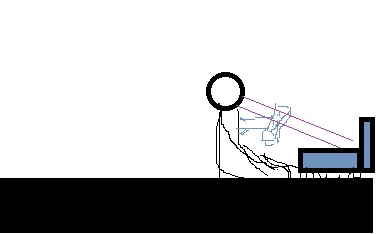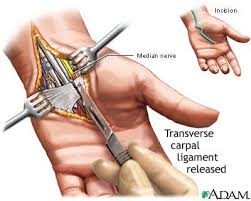Pain of Writing: Chicano Ergonomics, Part III
Simple changes can prevent injury when writing
Simple changes can prevent injury when writing
by Raymundo Eli Rojas
It's been a while since we've written in a piece in this series, so in this segment, I will focus on the use of the laptop.
The laptop is an anomaly in that the first home computers came with the screen and keyboard attached to one another. However, as computers became more common, consumers wanted the keyboard and monitor separate.
Laptops, which had been decreasing in size since 1968 when they were invented were first sold with the intention of them being portable devices.
However, what has occurred is people want to use laptops both for their portability and as a replacement for their desktop. Where the damage lies is that great steps have been made in ergonomics for using desktops, but ergonomics regarding the use of laptops remains far behind, and somewhat dangerous. Many people will not use it on their lap but on a desk.
The danger lies in several places:
- Placing the laptop on a table forces one to look at the screen in a hunched position, either hunching your neck and/or back downward. Even on you lap you are looking downward.
- The keyboard on most laptops is scrunched into a space even smaller than a desktop keyboard.
- By placing the laptop on the table, you have to raise you arms to the table stretching arms over the table. Injury can occur if the table is too high or even too low.
Aside from the other advice we have already given, like taking rests, there are a few things you can do to prevent injury or stop the pain you get while working on your laptop.
If you are away from home, you are on your own. The only think recommended is to use a mouse instead of the mouse pad that on your laptop.
However, at home there are several things you can do. First is to buy a separate screen and docking station. Another way is to buy a separate monitor screen and connect it to your laptop. Just make sure to elevate the screen.
The second way is that you have a docking station – most are molded as stands for your desktop monitor and you dock your laptop to your desktop. In this way, your desktop can access the files from your laptop as if it were another drive.
Now, some of us don't have the luxury of having a desktop and a laptop, so this is when a separate monitor screen comes into use.
The third way is to buy a laptop stand and separate keyboard. These come in several forms, but most elevate the laptop screen at an angle, however, with most you can't use the laptop's keyboard; you need a separate keyboard.Some stands are docking stations also, but some are not.
Now some of these are pricey, but you can make one on your own. This is where having a dad as a sheetmetal worker or carpenter comes to good use. My dad bend sheetmetal into a desktop podium-like shape that I can put my laptop upon. Almost exactly like the photos above. You can also make one out of card board.
Having a separate keyboard when at home may be a good idea. You simply put the laptop in its stand, connect the keyboard, and sit the keyboard on your lap or even you desks keyboard tray. You may even opt for a wireless keyboard which is better as you don't have to mess with wires.
The other problem with laptops is the mouse. Most laptops have a mouse pad which are very inconvenient. This is easily solved by connecting a regular mouse to the laptop. Now, they sell laptop mice, but most of these are made for traveling. Feel free to buy a regular mouse, preferably wireless and ergonomic, one that you would regularly use with a desktop, and connect it to your laptop. Make sure the mouse is close by either on the keyboard tray or if you have a mouse with a roller ball, you can put the mouse on your lap. As stated in previous segments, you can put a mouse pad on the arm of your office chair so that the mouse is close to your body. Remember, overextending to use your mouse causes injury.
Mouse
There are many different mice on the market. The best ones I've seen that are ergonomic are from Microsoft and Logitech. These either have track dials that allow you to page down and up. They are also build to fit snug in you hand. Logitech has one with roller balls, so that you don't have to move your forearm at all or need a foam mouse pad. The roller ball mouse stays stationary at all times, you move the cursor with the roller ball.
What if it's too late
So all of the above and in the previous entities will help whether you already have arm/wrist/hand injury or trying to prevent those injuries. Some research has shown that repetitive stress does not necessarily mean one will get Carpel Tunnel Syndrome (CTS). In 2007, research was presented at the American Academy of Orthopedic Surgeons that “people who continuously use their hands at work...don't develop CTS more frequently than other people” (Guide to Healing Food, James A. Duke). Much of it may be attributed to genetics as well as gender. Remember, women are more likely to develop CTS (Ibid.)
Wrist supports and splits
The old adage is to wear wrist/arm/hand supports. The recommendation of using these supports (or splits) while typing are varied, but most doctors I've talked to (mostly general practitioners) have said to wear them while I type. However, I've found them burdensome and only where them when I have a pain and I simply have to type.
Chinese balls
I've used these with some success, but sometimes I wonder if I'm further aggravating my injury. Supposedly, these balls with bells in them strength your hands, wrists, and fingers. I've found them useful to help relax my hands/arm/writs as well as myself. The other drawback, especially for guys, is that you are bound to get the old joke thrown at your that “you're playing with your balls.” Of course that will be the first time you heard that joke.
Anti-inflammatory balms and creams
I'm frequent to Abejas, but Aspecream, Icy Hot, you name it, these can help relieve some pain. A 2005 national survey by Stanford University, however, found that 50 percent of respondents said these creams were ineffective.
Chicanada #2: One thing I've tried is getting some lotion or cream, and mixing a little cayenne pepper into it, and rubbing them on your painful areas. Chile has capsaicin so it helps to relieve some pain. I'm not sure if this is cheaper than buying Icy Hot, as some of you may have seen the price of a good quality cayenne pepper these days.
Surgery
As with most surgery, and if you have seen anyone who has had surgery to alleviate their CTS, the surgery will leave a scar. Your office mates and colleagues may question if you have the stigmata, but if you fail to understand animal communications, you should be fine. Some have reported the surgery making the pain worse.
Wrist Support at Night
Now, we started this series with a description of people lying their heads on their hands and/or wrist at night while they sleep. This is often out of habit or because of pain. A 2005, study in the Archives of Physical Medicine and Rehabilitation had researchers at the University of Michigan studying the benefit of people wearing wrist supports at night. They found a 50% decrease in hand, wrist, elbow, forearm pain.
Well, ponder these, and we'll talk more in our next segment of Chicano Ergonomics, that's if I can type it.



















No comments:
Post a Comment